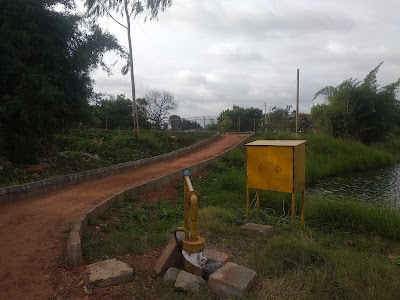Summary
Alahalli Lake, also called Avalahalli Lake, is on 23 acres with a walking path of 1.3km. It is located in the southern part of Bangalore next to Amruth Nagar Main Road and Nandi Gardens Apartment Complex. It was observed during our visit on 29th August 2020 that the lake was frequented by local residents. The lake was filled with water and many birds were observed!
This is mostly rain fed lake with less than 20% of sewage entering the lake as an overflow during the rainy season. A diversion drain which diverts the sewage from entering the lake is provided and connects all the inlets and takes the sewage to the outlet of the lake. There is an island at the center of the lake. There are two old wells at the outlet. One of the wells is functioning and water is used for domestic purposes by the community apart from drinking It was interesting to note that the water level in the well was higher than the lake water level. The other well was non functioning and was filled with garbage.
BBMP started rejuvenating this lake in 2017. They have completed phase 1 of rejuvenation. The lake has been fenced all around. There are 4 inlets and an outlet. There are two wetlands provided to two of the inlets. There is a walking path all around the lake.
Upstream and Downstream lakes
A’ A
Conceptual Section AA’
Overview and Observations
Alahalli Lake is shared between two survey numbers of Alahalli and Gollahalli villages, Bengaluru.
Alahalli Lake & Neighborhood Development Trust (ALNDT), the local corporator K. Somashekar, Pavitra Foundation, PROMAC Industries, and a few residents nearby have put efforts in the direction of rejuvenating the lake. In 2015-17, together citizens have spent about Rs. 20 lakhs for de-weeding, constructing a 100 meter walking path, repair and maintenance of fences, operation and maintenance.
BBMP started rejuvenating the lake in 2017. There is a walking path around the lake. It has two gates. The main gate is located on the North Western side. There is a small gate for villagers to use which is located on the Eastern side.
There are 3 inlets to the lake. Rajakaluve being one of the main inlet is situated at the North East side and two medium size drains in the East side of the lake. There is one outlet at the South end of the lake. The rajakaluve and one of the East side drain water enter the lake through a wetland. The inlets have a small wall built to stop the sewage inflow from the drains into the lake directly. There is a sewage diversion drain connecting all the inlets joining the outlet.
The design of the lake is like a soup bowl. The depth of the lake from inlet to outlet varies from 1m to 3m. The wetlands near the inlets have the depth of 2-3 feet. There was supposed to be wetlands in front of all the inlets, but currently the wetlands are provided only for 2 main inlets.
There is a graveyard located on the North East side of the lake.
It was observed that the health of the lake is better from years before the rejuvenation. Only during the monsoon, we were told the sewage enters the lake. The water from the inlets has a wall of 1-1.5 feet protecting the lake from sewage entry. Phase 1 of the lake rejuvenation has been completed by BBMP. They are awaiting Phase 2, when trees will be planted all around the lake. They are also planning benches, an inner fence around the waterbody, kalyani and a gym at the lake.
Livelihood activities such as fishing, grass cutting and cow grazing is allowed at the lake. Deweeding and maintenance work is done by BBMP. It has one central island for the birds to have its own habitat.
LAKE-
Inlets and outlets
Biodiversity-
In the second phase of rejuvenation by BBMP more trees and plants will be planted around the lake. Some of the flora and fauna observed around the lakes are documented below.
Trees and plants- There are mostly fruit bearing plants at the lake. The island of the lake has trees like Cashews, Jamoon etc. These were planted in Nov 2019. Around 40 plants and trees were planted on that island, but 32 of them have survived.
Central Island Trees along the path
Around the lake there are trees like Bettada hunase, Cholle hannina mara, Ficus, Rain tree, Acacia and Banyan tree
Birds and Insects-
There were a lot of Coots found in the lake. Some of the other birds that were spotted are Purple moorhen, Bronze tailed jacana, Purple heron, Little grebe, Pond heron, Cormorants, Pond heron.
Purple moorhen Coots
There were also dragon flies that were observed at the lake-
Cows at the lake-
Cows are allowed to graze at the lake.
Cow grazing
Livelihood-
The lake provides livelihood for grasscutters, fishermen and workers-
Weeds being removed from the bund
Wells at the lake-
There are 2 wells which are around 40-50 years old at the lake, one of them is a functioning well. Both are located next to each other and near the outlet. Functioning well is used for domestic purposes by the community around the lake apart from drinking.
Old Functioning well
Non-functioning well
Wetlands-
At Inlet one a Wetland of about an 1 acre treated the water before it enters the lake. The other wetland is about half an acre at the Inlet 2. Few wetland species observed are Typha, Water Hyacinth, Alligator weed, Knot weed, Cyperus, Water lily.
Timeline of the lake-
BBMP board at the lake
Contact Info
ALNDT contact ID- savealahallilake@gmail.com
References & Resources
1https://www.facebook.com/SaveAlahalliLake/
3http://www.deccanherald.com/content/587349/thanks-residents-alahalli-lake-cleared.html























